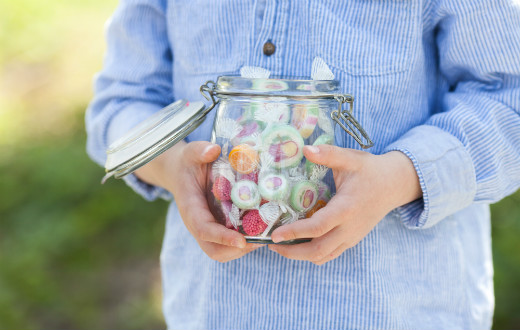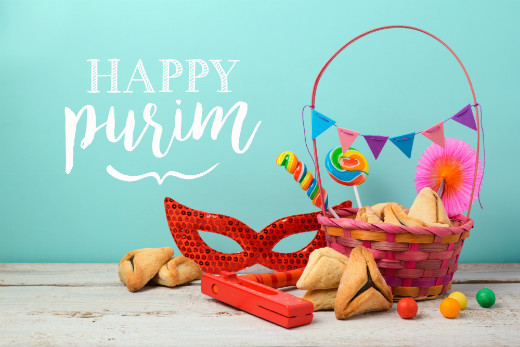By: Elisheva Blumberg, Lubicom Staff
Purim is coming up…cue the candy craziness!
It’s almost Purim and that means we need to prepare for our homes to be hit with a tornado of sugary treats. This can be overwhelming for both parents and children. Yeah… especially the parents.
Making rules to control your kids’ candy intake can seem like the best course of action.
However, labeling foods as “good” or “bad”, placing strict limitations on treats, and making a big deal out of nosh will only backfire in the long run.
.jpg)
This is not to say that high fructose corn syrup or Red #40 or any other artificial or highly-processed ingredient is the perfect standard of healthy food. Rather, the facts are that we live in a world surrounded with “play foods” and the healthiest way to deal with that is not to demonize processed foods (which can lead to extremist dieting behavior) but rather equalize the charge of food — that is, let our bodies rather than our minds figure out what is good for us. (And yes — when you subtract dieting from the equation, your body will tell you what it needs.)
When kids pick up on stressful messages regarding food and healthy eating, they will grow anxious about food. This may lead to a feeling of shame associated with food, and even disordered eating behaviors such as stealing or hiding “bad” foods, bingeing, purging, or fasting.

On the flip side, kids who grow up in an environment where food is dealt with in a healthy and moderate manner — where they are trusted around all kinds of food — have a greater chance of growing up as competent eaters.
(The following tips are based on the proven non-diet approaches of Evelyn Tribole and Elyse Resch’s Intuitive Eating and Ellyn Satter’s “division of responsibility.”)
The 5 Worst Ways to Deal with your Kids’ Purim Candy Cravings
- Have him hand out celery sticks and quinoa crackers
Now, don’t get me wrong – celery and quinoa are perfectly delicious foods…but not typically the ideal choice for a young child’s mishloach manot.When your child’s friends are distributing mishloach manot packages that are bursting with taffies, gumballs, and bottles of electric-blue sports drinks, you don’t want to force him to give out food his friends will wrinkles their noses at…and then toss straight into the trash.
It can be distressing for a child to be different than his friends; try to prepare mishloach manot that are similar to what the majority of your child’s friends give out.
- Take away her treats
Confiscating any candy or snacks you find objectionable will reinforce the message to your child that she cannot be trusted around food.Instead, let her know you believe in her ability to eat according to her body’s signals.
If she does eat until she feels sick, that’s okay! By giving her the chance to learn how different foods feel in her body – and that an entire bag of licorice makes for one nasty bellyache – she will learn how to listen to her body and make smarter decisions in the future.
- Set a treat deadline
Thinking of telling your kids that anything they don’t finish on the day of Purim will be thrown out afterward?Don’t do it! Although it can be tempting to get rid of all the nosh the morning after Purim, it will only serve to make your kids (and yourself) compelled to overeat on Purim itself. You know that frantic, eat-it-while-you-can mentality you feel the day before you start a new diet?
If you make candy only available on Purim itself, your kids will try to compensate for the future lack by proactively stuffing themselves. Instead, give them peace of mind by letting them know treats will be available again in the future.

- Make him eat “healthy food” first
We can all agree that eating chocolate-covered caramels on an empty stomach is never a good idea. But forcing a kid to eat a salad before he can chow down on “the good stuff” (i.e. chocolate and candy) will only serve to heighten the appeal of play foods while making vegetables seem distasteful.When you teach your child that there is a time and place for all foods to be enjoyed, he can learn to appreciate the fine flavors of his veggies as well as he does a candy bar.
Serving dessert/Purim treats along with more sustaining food will give your child the ability to experiment with taste and nourishment without the psychological baggage of a good food versus bad food battle.
If you turn the table into a war zone of “healthy food vs. good food, the “junk” always wins out! But when you do away with labels and allow your child freedom to choose for himself, you’ll find he can enjoy chickpeas and chicken just as much as chocolate.
- Call yourself fat
It’s no secret that the behaviors and attitudes we model for our kids affect them on the deepest of levels. If your child sees you anxiously counting calories, chiding yourself for “cheating” on your diet, or looking in the mirror and deriding your reflection, she will pick up on this behavior – and may even start doing these things herself.The worst of our obsessive, compulsive, and diet-driven food behaviors have a way of coming out on food-centered holidays… especially on Purim!
It is true that on Purim there’s an enemy we must despise, erase, and never forget its evil…
But it sure ain’t candy.





